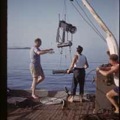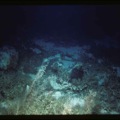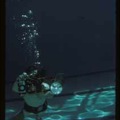|
Underwater Photography
In the mid-1930s, Doc was approached by E. Newton Harvey, an expert on bioluminescence, to track and photograph deep-sea bioluminescent fish for his upcoming book. This led Doc to focus on developing cameras, strobes and other instrumentation to be used in the deep sea. He designed his first successful underwater camera for oceanographic research in collaboration with researchers at WHOI in 1937.
Water causes light scattering and absorption effects that act like fog in the air, limiting range and performance. For this reason, photography under water is best used for close-up details, while sonar scanning tools are used for longer-range investigations. Electronic flash systems have become crucial for the development of underwater photography.
Over the decades Doc worked on underwater cameras ranging from hand-held types to stereo, deep-sea, and elapsed time movie cameras and cameras for silhouette photography. Specialized optical lenses were required, as well as effective electrical connections well protected from the corrosive salt water environment.
Doc’s lighting instruments included electronic flash lamps, strobes for a variety of submarine vehicles and strobes for underwater television cameras. As he described it, deep-sea lamp and camera design had to simultaneously balance a number of requirements: lamps had to produce high intensity of light, feature a strong container with high mechanical strength to withstand incredible pressure, and function with high efficiency to conserve batteries for missions that required hours for deploying and retrieving instruments, in addition to research bottom time.
Fieldwork out in the oceans was extremely demanding and unforgiving, but Doc seemed to maintain unflagging enthusiasm and optimism in the face of the direst technological mishaps – and bouts of debilitating seasickness.






